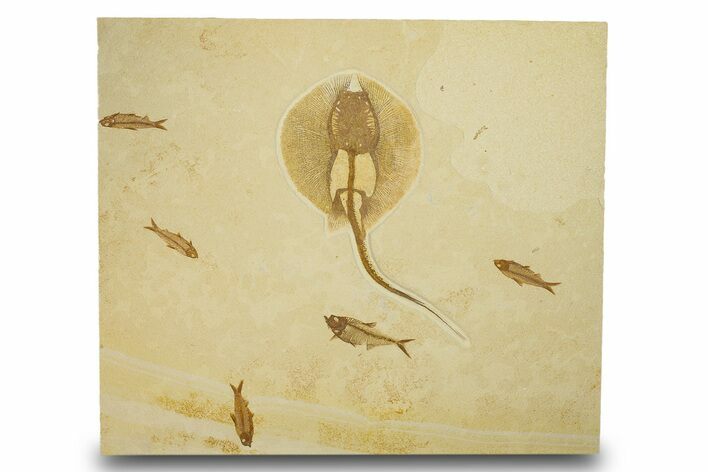This Specimen has been sold.
25.4" Wide, Fossil Fish Plate Featuring a Stingray - Wyoming
Due to the size and weight of this piece it will be shipped on a pallet or in a crate via freight. Our website cannot automatically calculate freight shipping costs, so these costs will be calculated and billed after purchase. Please contact us prior to purchase if you need a shipping quote.
This is a beautiful, 25.4" wide fossil fish "mural" featuring a stingray (Heliobatis radians). The fossil stingray is very detailed, 14.8" long (straightline), and has been inlaid into a piece of rock which has five other fossil fish (four Knightia eocaena and one Diplomystus dentatus. The Diplomystus measures 4.85" wide and the Knightia fish range in size from 3.1" to 3.6" wide.
It a very displayable piece that would look great hanging on a wall. The rock has been backed for stability and upon request we can install a wall hanger at no additional cost. The specimen will be shipped in a wooden crate on a pallet.
Heliobatis is an extinct genus of freshwater ray primarily known from the Green River Formation in Wyoming. The teeth are triangular and shaped for feeding on small fish, crustaceans, and mollusks.
About Fossil Lake
50 million years ago, in the Eocene epoch, these fish thrived in Fossil Lake, which was fed by the Uinta and Rocky Mountain highlands. The anoxic conditions at the bottom of Fossil Lake slowed bacterial decomposition, prevented scavengers from disturbing corpses, and, most interestingly, suffocated creatures that ventured into the oxygen-starved aquatic layer. The result is a miraculous exhibition of Eocene biota: a subtropical aquatic community within sycamore forests, teeming with creatures such as freshwater stingrays, dog-sized horses, menacing alligators, early flying bats, and one of the first primates.
50 million years ago, in the Eocene epoch, these fish thrived in Fossil Lake, which was fed by the Uinta and Rocky Mountain highlands. The anoxic conditions at the bottom of Fossil Lake slowed bacterial decomposition, prevented scavengers from disturbing corpses, and, most interestingly, suffocated creatures that ventured into the oxygen-starved aquatic layer. The result is a miraculous exhibition of Eocene biota: a subtropical aquatic community within sycamore forests, teeming with creatures such as freshwater stingrays, dog-sized horses, menacing alligators, early flying bats, and one of the first primates.
SPECIES
Heliobatis radians, Knightia eocaena & Diplomystus dentatus
LOCATION
Fossil Safari Quarry, Kemmerer, Wyoming
FORMATION
Green River Formation
SIZE
Rock: 25.4 x 22", Ray: 14.8" long (straightline), Weight: 27.7 lbs
CATEGORY
SUB CATEGORY
ITEM
#280236
We guarantee the authenticity of all of our specimens.
 Reviews
Reviews














